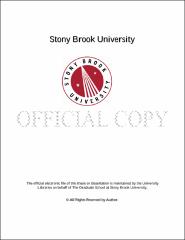| dc.identifier.uri | http://hdl.handle.net/11401/77021 | |
| dc.description.sponsorship | This work is sponsored by the Stony Brook University Graduate School in compliance with the requirements for completion of degree. | en_US |
| dc.format | Monograph | |
| dc.format.medium | Electronic Resource | en_US |
| dc.language.iso | en_US | |
| dc.publisher | The Graduate School, Stony Brook University: Stony Brook, NY. | |
| dc.type | Dissertation | |
| dcterms.abstract | All living reptiles belong to the crown clade Sauria, a subgroup of the ancient amniote clade Diapsida. Modern divergence estimates suggest an origin for Sauria in the Permian Period, just prior to the Permo-Triassic Extinction, which wiped out an estimated 95% of species. Although the Permian record of Diapsida is quite small, the subsequent Triassic record is substantial, with a huge array of body sizes and bauplans evident very early in the period. However, phylogenetic hypotheses for these early-diverging taxa are wildly inconsistent, such that our understanding of the origin and early radiation of the crown reptile clade during the Permian and Triassic is very poorly understood. For this dissertation, I present new insights into this important diversification event using novel phylogenetic data matrices. I employ this phylogenetic context to interpret a small reptile fauna from a Triassic fossil site in New Mexico, to resolve a problematic fossil lineage through description of the first three-dimensional material from the group and analysis of those fossils, and to examine the broad-scale patterns of taxonomic and morphological diversification before and after the PTE. I first employ this analysis to examine well-preserved fossils of early-diverging diapsid groups from the Upper Triassic Hayden Quarry (Chinle Formation) of New Mexico, a site that preserves some of the best fossil materials of small vertebrates in North America. The phylogenetic hypothesis allows the small reptile fauna to be analyzed in an apomorphy-based framework. One set of fossils belongs to Tanystropheidae, a clade of long-necked archosaur-line reptiles. These represent the first strong evidence for the group from western North America. The second set of fossils includes forelimb material from Drepanosaurus unguicaudatus, a small drepanosauromorph diapsid, previously known from Italy, with a highly modified forelimb. The three-dimensional fossils allow a conclusive determination of the homologies of the forelimb bones in Drepanosaurus, and the phylogenetic context illustrates a series of trait acquisitions in Drepanosauromorpha. I address long-standing questions about the affinities of Drepanosauromorpha among Triassic diapsid lineages through description the first three-dimensionally preserved skull from the group, also from the Upper Triassic of New Mexico. The material shows many morphological similarities to archaic, Permian diapsids in contrast to other early saurians, suggesting that drepanosauromorphs are outside of the crown clade Sauria. I describe the new skull in detail, with extensive comparisons to other Permo-Triassic reptiles. Finally, I present a novel data matrix of 303 morphological characters and present detailed results of this phylogenetic analysis. Although the phylogeny is well-resolved, there is substantial instability within the early-diverging saurian lineages, suggesting that small changes in character and taxon sampling can produce conflicting topologies. The results do suggest that much of the early diversification of Sauria occurred within the Permian, indicating many gaps in the diapsid fossil record. The optimizations of characters suggest that the ancestor of most archosaur-line reptiles was a long-necked and small-headed taxon. These studies illustrate a substantial complexity in the early diversification of Diapsida during the Permian Period. They also show that many of these early-diverging lineages radiated widely, attaining a substantial degree of morphological diversity during the Triassic Period. | |
| dcterms.available | 2017-09-20T16:51:40Z | |
| dcterms.contributor | Kley, Nathan | en_US |
| dcterms.contributor | Turner, Alan H | en_US |
| dcterms.contributor | Seiffert, Erik | en_US |
| dcterms.contributor | Conrad, Jack. | en_US |
| dcterms.creator | Pritchard, Adam Carl | |
| dcterms.dateAccepted | 2017-09-20T16:51:40Z | |
| dcterms.dateSubmitted | 2017-09-20T16:51:40Z | |
| dcterms.description | Department of Anatomical Sciences. | en_US |
| dcterms.extent | 805 pg. | en_US |
| dcterms.format | Application/PDF | en_US |
| dcterms.format | Monograph | |
| dcterms.identifier | http://hdl.handle.net/11401/77021 | |
| dcterms.issued | 2015-05-01 | |
| dcterms.language | en_US | |
| dcterms.provenance | Made available in DSpace on 2017-09-20T16:51:40Z (GMT). No. of bitstreams: 1
Pritchard_grad.sunysb_0771E_12485.pdf: 8050954 bytes, checksum: 0585ee1d95ade501db4fea5ca7fd7af0 (MD5)
Previous issue date: 2015 | en |
| dcterms.publisher | The Graduate School, Stony Brook University: Stony Brook, NY. | |
| dcterms.subject | Diapsida, Extinction, Permian, Reptilia, Systematics, Triassic | |
| dcterms.subject | Paleontology | |
| dcterms.title | The early evolution of diapsid reptiles and the origin of Sauria | |
| dcterms.type | Dissertation | |

